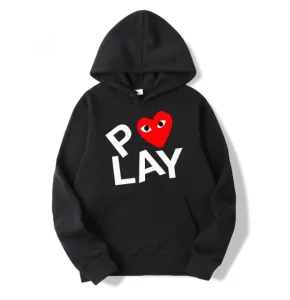In recent years, Germany’s design landscape has undergone a striking evolution shaped by the fusion of avant-garde experimentation and minimalist refinement. At the center of this cultural shift stands Comme des Garçons, a brand that has consistently challenged visual conventions while honoring restraint and structure. Its transition into Germany’s fashion and design sectors has transformed how designers, consumers, and retailers negotiate creativity, functionality, and individuality. By dissecting its influence, we can see how Comme des Garçons aligns with—and disrupts—the core aesthetics that define modern German design.
The Philosophical Bridge: Deconstruction and Discipline
Comme des Garçons’ ethos is rooted in deconstruction, a challenge to traditional silhouettes and wearable norms. Germany, with its historical affinity for functional minimalism and precise form, has absorbed this approach in unexpected yet seamless ways. German designers now embrace unusual tailoring, raw edges, and asymmetry while preserving the structural clarity that characterizes regional aesthetics. This intersection has pushed design houses and independent labels toward deeper experimentation while maintaining purpose and cohesion.
Minimalism with Edge: Redefining Classic German Aesthetics
Germany’s long-standing taste for clean lines and muted tones has always leaned toward minimalism. However, the arrival of Comme des Garçons introduced a new layer of creative boldness. Instead of erasing simplicity, the brand recontextualized minimalism. Neutral palettes and sculptural forms are now partnered with exaggerated volume, fragmented proportions, and concept-driven detailing. In this setting, restraint does not mean absence; it becomes a canvas for innovation.
Architectural Fashion and Spatial Design
Comme des Garçons has significantly impacted how German designers approach space and structure in both fashion and interiors. Clothing is treated like architecture: layered, modular, and engineered with intent. This perspective resonates deeply with Germany’s celebrated approach to industrial design and Bauhaus heritage. The brand’s influence encourages thinkers and makers to construct garments and environments where function supports creativity, not confines it. The result is a growing movement that celebrates silhouettes as spatial experiences rather than surface impressions.
Retail Spaces as Conceptual Environments
The brand’s retail presence in Germany epitomizes a hybrid of art installation and boutique experience. Inspired by Comme des Garçons’ signature concept stores, German retailers increasingly prioritize minimalistic interiors with sculptural furniture, negative space, and monochrome palettes. These environments elevate garments as artistic objects, not transactional products. This shift has encouraged luxury department stores and independent concept shops to integrate bold installations, modular displays, and gallery-style layouts to communicate identity.
Avant-Garde Materials and Experimental Craftsmanship
Comme des Garçons has introduced a renewed appreciation for innovative textiles and unconventional fabric manipulation in the German fashion sector. Deconstructed wool, layered tulle, coated cotton, and sculptural synthetics are now part of the visual vocabulary influencing German ateliers. Craftsmanship has expanded beyond precision cutting into intentional imperfection, raw finishes, and tactile contrasts. German designers have adopted this approach to push their material experimentation while preserving durability and function.
Gender Fluidity and the Rewriting of Form
The brand’s role in promoting genderless fashion has reshaped how German designers approach fit and identity. Tailoring that blurs masculine and feminine distinctions aligns with Germany’s progressive social attitudes and evolving consumer interests. Voluminous coats, structured dresses worn as coats, and layered ensembles invite reinterpretation rather than conformity. This shift contributes to a broader reimagining of menswear and womenswear into open categories defined by aesthetics rather than convention.
Collaboration and Local Influence
Comme des Garçons’ collaborations with international artists, labels, and designers have encouraged similar partnerships within Germany. The brand’s philosophy shows that cross-disciplinary dialogue can yield renewed aesthetics without sacrificing authenticity. German creatives—from emerging streetwear brands in Berlin to ateliers in Hamburg and Munich—now explore partnerships integrating performance art, digital design, and contemporary craftsmanship. These collaborations reflect a commitment to building a globally aware yet locally relevant design culture.
Sustainable Minimalism with Avant-Garde Values
Germany’s longstanding dedication to sustainability has found a compelling ally in Comme des Garçons’ philosophy of longevity and conceptual integrity. Rather than fast-fashion cycles, the focus turns to lasting pieces defined by artistic merit and structural quality. Designers note the power of fewer pieces crafted with intention, where minimalism serves eco-conscious design and avant-garde thinking resists wasteful production. This dynamic champions a culture in which creativity and responsibility coexist.
Cultural Identity Through Experimental Design
Comme des Garçons’ continued influence in Germany reflects a deeper cultural shift toward individual expression. The brand encourages designers and consumers alike to challenge aesthetic norms without abandoning heritage. By embracing the tension between rebellion and refinement, the German design scene is cultivating a new identity that respects its architectural roots and welcomes the bold language of conceptual fashion.
The Future: A Harmonized Design Movement
The ongoing integration of avant-garde principles into Germany’s minimalistic core suggests a future where expression honors balance. Comme des Garçons has not imposed a style; it has activated a new design conversation. From fashion runways to concept boutiques and cross-industry collaborations, the path forward blends aesthetic clarity with intellectual edge. This evolution strengthens Germany’s role as a leader in global design innovation—where function, abstraction, and form coexist without compromise.
Conclusion: Redefining Possibility Through Contrast
The impact of Comme des Garçons on German design trends demonstrates the power of contrast as a creative force. By merging conceptual depth CDG Hoodie with minimalist discipline, the brand has reshaped how Germany interprets fashion, architecture, retail, and cultural identity. This evolution is not a trend but a transformation: a sustained movement redefining how avant-garde vision and minimalist clarity can coexist to generate powerful new expressions. As Germany continues to reinterpret its design values through this lens, its creative landscape will remain intellectually potent, globally relevant, and artistically fearless.
